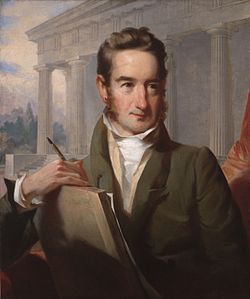William Strickland (1788-1854)
 Click on image to enlarge or for higher resolution |
Title/Occupation | Architect |
|---|---|---|
| Address | 55 The Strand? 6 The Strand? | |
| Artist | John Neagle | |
| Date painted | ||
| Credit | ||
| Married | Rachel Trenchard (1812) | |
| Parents | ||
| Children | ||
Wikipedia | ||
Latrobe's Apprentices in New CastleWilliam Strickland and Robert MillsSearching via Google for "America's first architect" picks up numerous links to the British born and European trained Benjamin Latrobe. Searching instead for the first architect born or trained in American picks up Strickland and Mills.All three men were proponents of Greek Revival style of architecture. Their designs were prominent.
Latrobe: the U. S. Capitol dome, White house portico, Washington Navy Yard gate and Baltimore cathedral. Strickland: Second National Bank of the U.S., U. S. Mint, U. S. Naval Asylum (all in Philadelphia) Mills: Washington Monument, Dept. of Treasury, Patent Office (now Portrait Gallery) (all in Washington) It's remarkable that all three men lived in New Castle for periods between 1803 and 1805. Latrobe had two apprentices while he worked on the C&D canal and did the survey of New Castle: the methodical and dependable 22 year old Robert Mills, " the first architect trained in America", and the brilliant and undependable 14 year old William Strickland. I assume that Strickland and Mills, as apprentices, lived with Latrobe in the house he rented from widow Aull. This was 55 The Strand, according to Lucille Toro's thesis. However, Latrobe also rented office space in the Caleb Bennett (Gunning Bedford) house at 6 The Strand, and the apprentices may have lived there. Strickland and Latrobe competed for the contract to design the Second bank of the United States. Strickland won. His portrait, shown above, includes the bank in the background. He designed so many buildings in Philadelphia, that he became known as "the city architect" In her thesis on the Latrobe Survey, Lucille Toro wrote:
The talented but somewhat irresponsible William Strickland,
apprenticed to Latrobe in 1801, also worked on the survey. It appears
he caused Latrobe much annoyance during the four short years he was with
him. When the master was close at hand to supervise the youth, his work
went well, but when the student was left to his own initiative to carry
out orders, things went amiss. This is particularly seen in a letter
Latrobe sent to Strickland's father, August 18, 1804.
Although I am still of opinion that your son William has
the best talents and disposition I have almost ever seen
united in a boy of his age,--his conduct has been such
as to render it necessary to use him with great severity.-For
the last fortnight he has been with me in Philadelphia,
and being constantly under my eye he had behaved
well, and done me 'and himself much service.
The letter continues that Latrobe sent Strickland to New Castle to open the house and be ready to receive the family. When the Latrobes arrived, they found the house damp and filled with mildew. William was not to be found. But in time Latrobe learned he had gone on a fishing party to Salem. Latrobe sent him home as punishment; later he was taken back and continued to work with Latrobe until the middle of the next summer. Absenting himself without permission in August of 1805, Strickland was dismissed from Latrobe's office. The final work by Strickland in his capacity as a student of Latrobe was the New Castle survey, as verified in the dismissal letter.
I enclose a draft for your share of the sum to be paid
by the commissioners of the town of Newcastle for the
regulation of the streets formerly promised to be divided
among my pupils, which will be paid after you,
shall have assisted Mr. Mills in setting out the same.
For many years Latrobe retained his admiration for Strickland's talents and recommended him highly as a draftsman. The controversy about the Second Bank of the United States in Philadelphia, in 1819, again estranged them. This was Strickland's first big commission after leaving Latrobe. Reference: The Latrobe Survey of New Castle, Lucille Toro, Thesis, Univ. of Delaware, 1971 | ||
Jim Meek
nc-chap.org 2014, 2015
nc-chap.org 2014, 2015